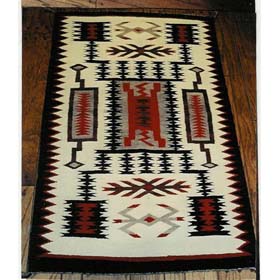Navajo Rugs

Navajo rugs are rising in popularity because of the trend in Southwestern decors. The originals were made on the reservations with traditional Navajo designs. A good book on American Indian arts and crafts should teach you all you need to know about recognizing these rugs for their collector's value. There are many deceptive imitations on the market, so be careful.
The weaving of Navajo Rugs is a dieing art. Fewer and fewer young people are
learning to weave from their mothers and grandmothers. It is a shame that this
traditional art may fall by the wayside. There are a few traders who are working
to keep Navajo Rugs a tradition that survives the future.
Older Navajo's are helping young ladies with their weaving, in the hopes
that they will keep this art form vital and alive, as well as being able to make
a living for their families through their art.
The cheaply made Mexican rugs have replaced the traditional Navajo Rugs in many
markets. The quality of the Mexican rugs, their texture, and the vibrancy of the
colors are inferior. Don't waste your money. Save and buy yourself a true piece
of art. The Navajo Rugs are more expensive, but you will have made an
investment. A truly good piece will only increase in value, while it's Mexican
counterpart will only be good for resale at a yard sale.
Each area of the Reservation has it's own style of rug. The Klagatoh Red is from
Klagatoh Arizona, the storm pattern is from Tuba City,
Arizona. Around the turn of the century, many of the local traders encouraged
their local weavers to weave rugs of similar colors and patterns to make a
standard for their particular area of the Reservation. The most well known of
the Traders was John Lorenzo Hubble, who popularized the Navajo Rug in the
beginning of this century. He coached the area weavers into making patterns that
he could sell to the "Beliganas" (whites) all over the country.
The Two Grey Hills Rug above, is made from all natural colors. Meaning their
were no commercial or vegital dyes used. The variations in the colors is made by
expertly spinning different shades of wool into yarn. The black comes from sheep
that produce black wool, the white from sheep that produce white wool, and the
different shades of grey come from a combination of both. This style of rug is
very time consuming for the weaver. She must first raise her sheep, shear them,
clean and card the wool, then spin the wool into yarn of the desired shade. Only
then can she start the time consuming task of weaving her rug. Some of the women
who weave still use an awl to spin their yarn. They spin the awl on their leg,
while twisting the yarn to the desired thickness with their other hand. It is
fascinating to watch, and the true masters of this art make it look simple. It
is not simple, getting each strand of yarn the same size, the same shade, is
very tricky, and is why many women buy commercial yarns. The hand spun wool
varies in thickness more than the commercial wools, but the hand spun rugs are
more valuable.
One of the most fascinating things about these rugs, is that they use no
pattern. The picture of what they want is in their mind, and comes out into the
rug through their fingers. Many of the Navajo Rugs have a spirit string. This is
a small piece of unwoven yarn exiting the rug from the top left hand corner. The
weaver leaves this yarn loose for a reason, and it is not a flaw. The weaver
will have spent months of their lives in front of their loom, and believe that
the pattern is one that their spirit has created within themselves. They leave
the string unwoven so that their spirit can escape the rug, and find it's way
back to their souls. If you are looking for a rug to purchase, look for one with
a spirit yarn.